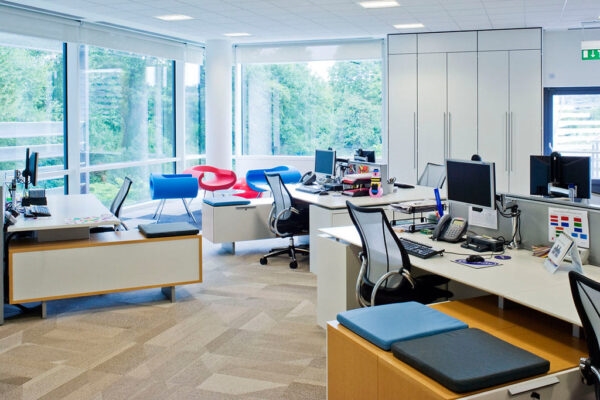
Imagine this scenario. You are a 40-something Gen Xer who has managed to finally summon the courage to change jobs and ditch the old cubicle farm to join a hip technology company with Silicon Valley origins. You are rightfully ecstatic and cannot wait to take part, however small, in something innovative and revolutionary.
You show up for your first day at work all lit up with the joy of a millennial who was just supplied his first avocado toast in a quaint Instagrammable café.
An assigned buddy or a team lead gives you the lay of the land. Italian espresso machines: check. Pool tables: noted. Sleep pods: seen. A functionally chic cafeteria that serves catered lunches and hosts a salad bar: present. Floor-to-ceiling windows that let in natural light to boost employee happiness: undeniable in their brightness. Stylish meeting nooks and mini-lounges that marry function and design: invitingly accessible.
You are then herded to the main work area where rows of long white desks are occupied nearly shoulder-to-shoulder by tech jeans looking at screens of code, writing email, or huddled with three or five others in a technical discussion that may best be done in a closed conference room. In fact, you see two to three huddles concurrently happening around you. You take in the noise and the minor frenzy but also notice how everyone else seems oblivious to it. Welcome to your first open-plan office!
In here, collaboration is king and “barriers” is a relic word mostly used in the same vein as “sugar.” It is time to shed your cubicle hermitage past and partake.
The open-plan office is not a new phenomenon. It was first employed, albeit not widely adopted, in 1936, by the architect Frank Lloyd Wright for the SC Johnson Wax Company, in efforts to improve employee happiness and morale. It gained real traction in the last couple of decades with the rise of technology companies and the widespread application of the Agile software methodology which required adaptive and evolutionary development and continual improvement. Constant collaboration is inherent in Agile, and the no-barrier workspace organically engendered a culture of openness, a speedy and flexible resolution to issues, and supported flat hierarchies.
By 2014, at least 70 percent of offices used the open-plan layout. Facebook’s Menlo Park Campus, completed in 2012, epitomizes the open office. Soon after, most companies, including non-software organizations, caught on and adopted the plan.
Although certain studies are now showing that the open layout may have more downsides than upsides, the trend does not appear to be going away anytime soon. How do you cope if you are used to the traditional walled cubicle and work more effectively in a less frenetic and more private environment? Here are some tips that may ease the pain.
1. Embrace the change and master the art of the soft ambush.
The open office is built into the DNAs of most companies. It is a physical component of a company’s culture, and at this juncture for you, it is only counterproductive to challenge and resist it. Focus on the positives of the new setup instead of marinating on the negatives. Make it work for you. In an open office, there is no shame in going over to someone else’s workstation unannounced to follow up on that important email. In fact, it is encouraged.
According to SetSchedule’s CHRO, Shayna Goldburg, “Collaboration is necessary for innovation, which is essential to be successful in today’s business climate. One of the best things about an open office floor plan is the ability to collaborate easily with coworkers even if they don’t do the same job you do. The design team can talk to the customer service team about what customers are saying about their experiences using the product. Or upper management can talk to an intern about their training program. Open office floors allow for more collaboration which could lead to innovations not possible when teams are isolated from each other.”
In your old job, your boss is locked in her corner office at most times of the day and become nearly impossible to approach for that final signoff that you need. In an open office, you can sit next to her and casually ask her about it. Master the art of the soft ambush, wherein the other party is not left feeling bamboozled with requests and demands. Instead, involve the other party in a discussion that is geared towards the quick resolution of a problem that would benefit all, not just you. Approach people in a calm, and professional manner. Do not be a malingerer and eat up someone else’s working hours.
Openness fosters camaraderie. You will find that it is easier and quicker to get things done when everyone you need is there for you to approach. The open culture nurtures collaboration. Take advantage and allow it to do most of the work for you.
2. Maximize the use of available informal spaces.
When it’s time to work on that document or code that requires your focus and concentration, look for a private nook or book a small conference room, away from the timesuck meetings and unscheduled huddles. Most modern offices have these in abundance and maximize their use.
3. Make earphones your friend.
Now, more than ever is the best time to become an earphone connoisseur. It can be your best friend in navigating the new layout. Whether it’s one of those noise-canceling buds or a high definition surround gadget that will blare hip-hop into your soul is up to you. Pick one that can help you focus. You can put them on in lieu of a “Do Not Disturb” sign to signal to others that you would rather not be disturbed at this time.
4. Create a daily to-do list and try to stick to it.
The open office is a prime breeding ground for impromptu meetings that can siphon a chunk of your working hours. Create a to-do list at the start of the day, and be mindful of your important deliverables and timelines. Make sure to prioritize these and know when a huddle or a meeting is taking too much of your time and is going nowhere. If a discussion is going to help with your deliverables, then stay for a while. Otherwise, bail out.
5. Choose your workstation strategically.
At the start of each day, be conscious of what needs to be accomplished. Is it a day to gather information and feedback? Do you need to touch base with a particular stakeholder? Perhaps you can choose a workstation near that person. Are you trying to meet a deadline and need to focus for most of the day? Select a corner or quiet spot that’s far from the buzz. You need to spend your first days observing the lay of the land to identify the busy spots and the quiet corners.
Open office is built on fundamentally sound principles. It encourages easy collaboration, group effort, and quick and flexible resolution to issues that impact the organization’s end product. However, it can also hinder productivity, breed countless unplanned meetings, and violate spatial boundaries. Employ workarounds (such as those given above) to navigate your new environment and to manage your tasks more effectively.
Business & Finance Articles on Business 2 Community
(22)






